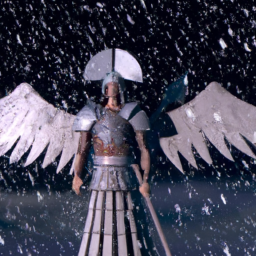“Revealing the Divine Beauty of Biblical Angels”
Introduction
Unveiling the True Appearance of Biblical Angels is a topic that delves into the fascinating realm of angelology, seeking to shed light on the appearance of angels as described in the Bible. This subject has captivated the curiosity of scholars, theologians, and believers alike, as the biblical accounts provide glimpses into the celestial beings that serve as messengers and servants of God. By examining the scriptural references and interpretations, this exploration aims to uncover the true nature and appearance of these enigmatic beings, offering insights into their divine purpose and significance within religious traditions.
The Role of Angels in Biblical Texts: Unveiling their True Appearance
Unveiling the True Appearance of Biblical Angels
Angels have long been a subject of fascination and intrigue, captivating the imaginations of believers and non-believers alike. These celestial beings are mentioned throughout the Bible, playing significant roles in various biblical texts. However, the true appearance of angels has often been a matter of speculation and interpretation. In this article, we will delve into the role of angels in biblical texts and attempt to unveil their true appearance.
Angels are depicted as messengers of God, carrying out His divine will and delivering important messages to humans. They are often described as beings of great beauty and radiance, with wings that enable them to move swiftly and effortlessly. The Bible frequently portrays angels as having a human-like form, appearing to individuals in times of need or revelation.
One of the most well-known appearances of angels in the Bible is the story of the Annunciation, where the angel Gabriel appears to the Virgin Mary to announce that she will conceive and bear a son, Jesus. In this account, Gabriel is described as a majestic being, radiating with heavenly light. This depiction aligns with the common perception of angels as ethereal and awe-inspiring beings.
Another notable appearance of angels is in the story of Jacob’s ladder. Jacob, fleeing from his brother Esau, dreams of a ladder reaching from earth to heaven, with angels ascending and descending upon it. These angels are described as having a human-like form, further reinforcing the idea that angels possess a physical appearance similar to that of humans.
However, it is important to note that not all biblical texts provide detailed descriptions of angels. In some instances, angels are simply referred to as messengers without any physical attributes mentioned. This lack of physical description allows for a wide range of interpretations and artistic representations of angels throughout history.
In addition to their physical appearance, angels are often associated with specific attributes and symbols. For example, the cherubim and seraphim are two types of angels mentioned in the Bible. Cherubim are often depicted as winged creatures with multiple faces, while seraphim are described as having six wings. These descriptions, although not providing a complete picture of their appearance, offer glimpses into the diversity and complexity of angelic beings.
It is worth mentioning that the true appearance of angels may transcend our limited human understanding. As spiritual beings, angels exist in a realm beyond our physical world, and their appearance may be beyond our comprehension. The descriptions provided in biblical texts serve as a means to convey their significance and divine nature rather than a literal representation of their appearance.
In conclusion, the role of angels in biblical texts is significant and multifaceted. While their true appearance may remain a mystery, the Bible offers glimpses into their beauty and radiance. Angels are depicted as messengers of God, appearing to individuals in times of need or revelation. Their physical appearance is often described as human-like, with wings that enable them to move swiftly. However, it is important to remember that these descriptions are symbolic and may not fully capture the true essence of these celestial beings. Ultimately, the true appearance of angels may be beyond our comprehension, as they exist in a realm beyond our physical world.
Unraveling the Symbolism of Angelic Imagery in the Bible

Unveiling the True Appearance of Biblical Angels
Throughout the Bible, angels are depicted as celestial beings with a divine purpose. Their appearances are often described as awe-inspiring, radiating a sense of power and holiness. However, the true appearance of these angelic beings is a subject of much debate and interpretation. In this article, we will delve into the symbolism of angelic imagery in the Bible, seeking to unravel the mystery behind their true appearance.
When we think of angels, the image that often comes to mind is that of a winged creature with a halo, dressed in flowing white robes. This popular depiction has been influenced by centuries of artistic interpretations and cultural beliefs. However, it is important to note that the Bible itself does not provide a detailed physical description of angels.
Instead, the Bible focuses on the spiritual nature and purpose of angels rather than their physical appearance. Angels are described as messengers of God, sent to deliver important messages or carry out divine tasks. Their primary role is to serve and worship God, acting as intermediaries between the divine and human realms.
In the Old Testament, angels are often described as beings of light or fire. For example, in the book of Daniel, an angel appears to him, shining with a brightness that surpasses the sun. This imagery of radiant light symbolizes the holiness and purity of these celestial beings. It suggests that angels are beings of divine energy, emanating a powerful presence.
Another common symbol associated with angels is wings. While the Bible does mention angels with wings, it is important to understand that these wings are not necessarily a physical attribute. Rather, they represent the ability of angels to move swiftly and effortlessly between heaven and earth. Wings symbolize their celestial nature and their capacity to carry out God’s will.
Furthermore, angels are often described as having multiple faces or eyes. This symbolism represents their omniscience and their ability to see and understand all things. It signifies their role as messengers who possess divine knowledge and insight.
It is also worth noting that angels are sometimes depicted as having a human-like appearance. This human form allows them to interact with humans and deliver their messages in a relatable manner. However, it is important to remember that angels are not human beings. They are spiritual beings with a higher purpose and a direct connection to the divine.
In conclusion, the true appearance of biblical angels is a subject of interpretation and symbolism. While popular culture often portrays them as winged creatures with halos, the Bible itself does not provide a detailed physical description. Instead, the focus is on their spiritual nature and their role as messengers of God. Angels are depicted as beings of light, radiating holiness and purity. Their wings symbolize their celestial nature and their ability to carry out divine tasks. Multiple faces or eyes represent their omniscience and divine knowledge. Ultimately, the true appearance of angels is a mystery that invites us to contemplate the divine and the spiritual realm beyond our earthly understanding.
Debunking Common Misconceptions: Understanding the True Nature of Biblical Angels
Unveiling the True Appearance of Biblical Angels
When it comes to biblical angels, there are many misconceptions that have been perpetuated over the years. These misconceptions often stem from artistic interpretations, popular culture, and even personal beliefs. However, it is important to understand the true nature and appearance of biblical angels, as described in the Bible itself.
Contrary to popular belief, biblical angels are not chubby cherubs with wings and halos. In fact, the Bible describes angels as powerful and majestic beings, often appearing in human form. They are messengers of God, carrying out His will and delivering important messages to humans.
One of the most well-known appearances of an angel in the Bible is the angel Gabriel. Gabriel is described as a powerful and awe-inspiring figure, appearing to the prophet Daniel and the Virgin Mary. In both instances, Gabriel’s appearance caused fear and awe in those who witnessed him. This depiction of angels as powerful and majestic beings is consistent throughout the Bible.
Another misconception about biblical angels is that they have wings. While angels are often depicted with wings in art and popular culture, the Bible does not explicitly mention angels having wings. In fact, the only biblical beings described as having wings are the seraphim and cherubim, which are a different type of celestial being altogether.
The appearance of angels in the Bible is often described as radiant and shining. They are often depicted as wearing white robes and emanating a bright light. This radiant appearance is a reflection of their divine nature and their close proximity to God. It is important to note that this radiant appearance is not limited to their physical form, but also extends to their presence and the aura of holiness that surrounds them.
In addition to their appearance, biblical angels are also described as having various roles and responsibilities. Some angels are messengers, delivering important messages from God to humans. Others are warriors, fighting against evil forces and protecting God’s people. Still, others are worshippers, constantly praising and glorifying God in heaven.
It is also worth noting that angels are not to be worshipped or prayed to. They are not divine beings themselves, but rather servants of God. In the Bible, angels are often quick to redirect any worship or praise towards God, emphasizing their role as messengers and servants.
Understanding the true nature and appearance of biblical angels is important for a proper interpretation of biblical texts. By debunking common misconceptions, we can gain a deeper understanding of the role and significance of angels in the Bible. They are not cute and cuddly cherubs, but rather powerful and majestic beings who carry out God’s will.
In conclusion, biblical angels are not chubby cherubs with wings and halos, as often depicted in popular culture. They are powerful and majestic beings, appearing in human form and radiating a bright light. Their appearance is a reflection of their divine nature and their close proximity to God. Understanding the true nature of biblical angels is crucial for a proper interpretation of biblical texts and a deeper appreciation of their role in God’s plan.
Q&A
1. What is the book “Unveiling the True Appearance of Biblical Angels” about?
The book explores the true appearance of angels as described in the Bible.
2. Who is the author of “Unveiling the True Appearance of Biblical Angels”?
The author of the book is not specified in the question.
3. What is the purpose of “Unveiling the True Appearance of Biblical Angels”?
The purpose of the book is to provide insights and interpretations on the physical appearance of angels as depicted in the Bible.
Conclusion
In conclusion, the concept of unveiling the true appearance of biblical angels is a complex and subjective topic. While the Bible provides some descriptions and depictions of angels, these descriptions are often symbolic and open to interpretation. Therefore, attempting to determine the true appearance of biblical angels is a challenging task that may vary depending on individual beliefs and perspectives.

